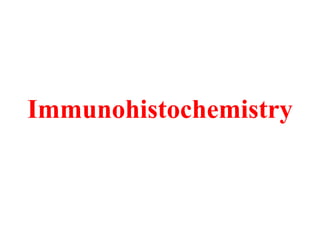
Visualize Cell Components with Immunohistochemistry
- 2. Introduction • Immunohistochemistry (IHC) combines histological, immunological and biochemical techniques for the identification of specific tissue components by means of a specific antigen/antibody reaction tagged with a visible label. • IHC makes it possible to visualize the distribution and localization of specific cellular components within a cell or tissue.
- 3. • Application of antibodies to tissue preparation for the localization of target antigens: • Wide range of specific antibodies • Highly sensitive detection system
- 4. Immunohistochemistry utilizes labeled antibodies to localize specific cell and tissue antigens, and is among the most sensitive and specific histochemical techniques. Because many targeted antigens are proteins whose structure might be altered by fixation and clearing, so frozen sections are commonly used. In some cases, paraffin wax can be used for embedding.
- 5. Immunohistochemistry assays may use Cells grown, spun into a pellet, frozen or paraffin embedded and sectioned Cells grown as a monolayer OR use tissue sections that are frozen or paraffin embedded Sections from tissues contain many different kinds of cells as well as extra-cellular matrix components cells on slides
- 6. If the tissue is frozen The sections may need to be used in immunohisto-assays as Tissue section on glass slide: Frozen Acetone fixed: - precipitates proteins onto cell surface---may extract lipids -is needed for many of the “CD” antibodies Unfixed: Positive feature:-antigens are unaltered Negative feature: sections may fall off slide during staining Paraformaldehyde fixed: --needs to be freshly made, or frozen soon after --is preferred over using 10% buffered formalin
- 7. Tissue section: Paraffin embedded If the tissue is paraffin embedded, - Deparaffinize ( remove the infiltrated paraffin wax, by using organic solvents) - The section then needs to be rehydrated, by sequential immersion in graded alcohols (100%, 70% , 50% and then PBS) - The deparaffinized section may need to be treated to expose buried antigenic epitopes with either proteases or by heating in low pH citrate buffer , or high pH EDTA buffer (Antigen Retrieval)
- 8. Principle • The principle of immunohistochemistry is the localization of antigens in tissue sections by the use of labeled antibodies as specific reagents through antigen- antibody interactions that are visualized by a marker such as fluorescent dye, enzyme, radioactive element or colloidal gold.
- 9. Antibodies (Immunoglobulins) • Glycoprotein that are produced by plasma cells and used by the immune system to identify and neutralise foreign objects, ie. bacteria and viruses • recognise a specific Antigen- mainly proteins, glycoprotein, polysaccharides • Complementary Determining Region
- 11. Antibodies binding to Antigens
- 12. Antigens
- 13. A. Raising Antibodies: • Repeated injection of antigens (proteins, glycoproteins, proteoglycans, and some polysaccharides) causes the injected animal's B lymphocytes to differentiate into plasma cells and produce antibodies. • Members of a lymphocyte clone (descendents of a single lymphocyte) produce a single type of antibody, which binds to a specific antigenic site, or epitope.
- 14. 1. Polyclonal antibodies: Large complex antigens may have multiple epitopes and elicit several antibody types. Mixtures of different antibodies to a single antigen are called polyclonal antibodies. 2. Monoclonal antibodies: Antibodies specific for a single epitope and produced by a single clone are called monoclonal antibodies and are commonly raised in mice.
- 15. B. Labeling Antibodies: • Antibodies are not visible with standard microscopy and must be labeled in a manner that does not interfere with their binding specificity. • Common labels include fluorochromes (eg, fluorescein, rhodamine), enzymes demonstrable via enzyme histochemical techniques (eg, peroxidase, alkaline phosphatase), and electron-scattering compounds for use in electron microscopy (eg, ferritin, colloidal gold).
- 16. Method • Direct Method • Indirect Method • PAP Method
- 17. Direct Method Tissue Antigen Labeled Antibody
- 18. Two-Step Indirect Method Tissue Antigen Primary Antibody Secondary Antibody
- 19. PAP Method (peroxidase anti-peroxidase method)
- 20. Applications • Cancer diagnostics • differential diagnosis • Treatment of cancer • Research
- 22. Part 1 1. Fixation Fresh unfixed, fixed, or formalin fixation and paraffin embedding 2. Sectioning 3. Whole Mount Preparation Tissue preparation
- 23. Part 2 1. Antigen retrieval Proteolytic enzyme method and Heat-induced method 2. Inhibition of endogenous tissue components 3% H2O2, 0.01% avidin 3. Blocking of nonspecific sites 10% normal serum pretreatment
- 24. Part 3 • Make a selection based on the type of specimen, the primary antibody, the degree of sensitivity and the processing time required. staining
- 25. Controls • Positive Control It is to test for a protocol or procedure used. It will be ideal to use the tissue of known positive as a control. • Negative Control It is to test for the specificity of the antibody involved.